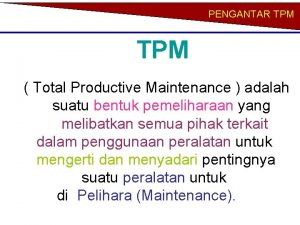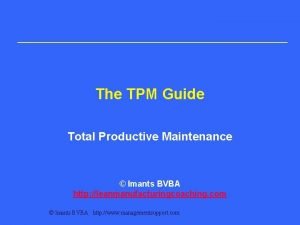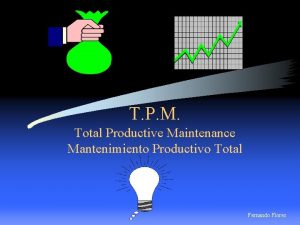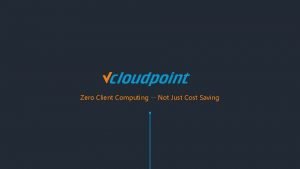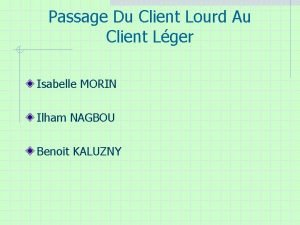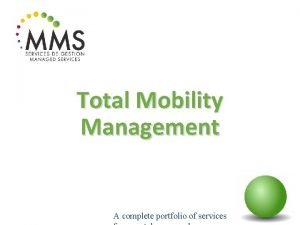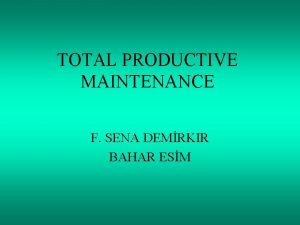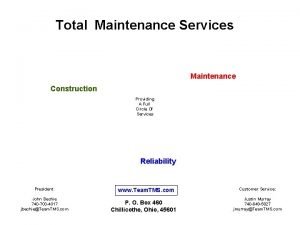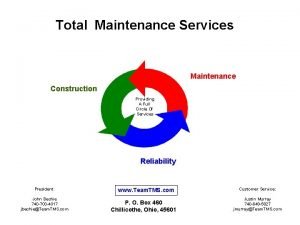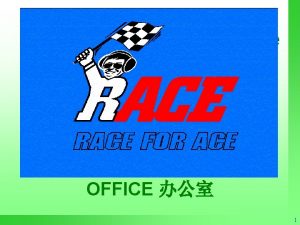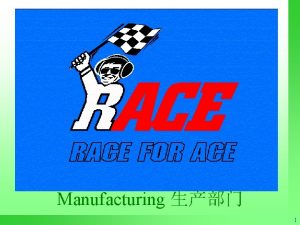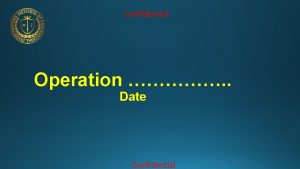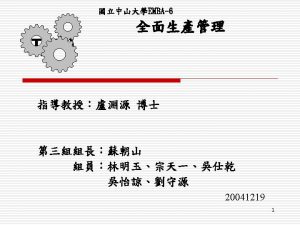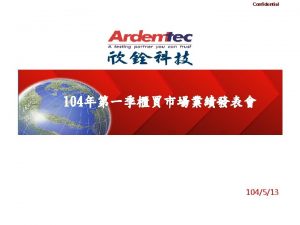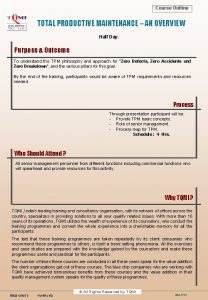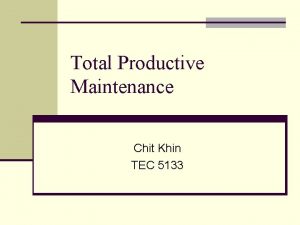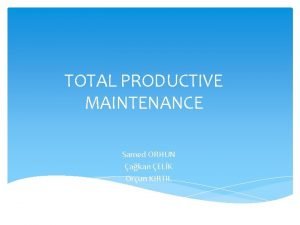CONFIDENTIAL Total Productive Maintenance Client 12 July 1999

















- Slides: 17

CONFIDENTIAL Total Productive Maintenance Client 12 July 1999 This report is solely for the use of client personnel. No part of it may be circulated, quoted, or reproduced for distribution outside the client organisation without prior written approval from Mc. Kinsey & Company. This material was used by Mc. Kinsey & Company during an oral presentation; it is not a complete record of the discussion. Issue 1, 21/12/98

PSDC Lean Transformation Model Over processing Transportation Rework Inventory Waiting Motion Waste Change management Work environment Organisation structure Competitiveness TPM Process measurement & review Standardised operations FMS Operating system Lean manufacturing methodology SS Workplace organisation Machine design Line design Factory design Elimination of waste Intelligent automation Poka Yoke Performance monitoring Problem resolution Continuous flow processing JIT Quality system Autonomation Minimum Lead time Element Continuous improvement culture Lowest Possible Cost Zero Defect Total Quality Profitability Process Maximized people contribution People system Enabler Delivery Reliability Human Resource Management Stable Employee Relations Business need Over production Process and effect Takt time Pull system Levelled production Sustainability and Continuous Improvement 1

Definition Total Productive Maintenance (TPM) is productive maintenance carried out by all employees 2

A brief history of maintenance Breakdown maintenance Preventive maintenance Time -1940 s 1950 s - 1960 s 1970 s - Characteristics Firefighting Planning Treat the cause Involve everyone Attitudes “If it ain’t broke, don’t fix it” “You make it, we’ll maintain it” “Why did it break down? ” “You make it, we’ll fix it” Effect Costly Risky Inefficient Productive Maintenance TPM “How can we prevent it happening again? ” Improvement Ongoing production/ maintenance split Root cause solutions More reliable equipment 3

A model for TPM Top Management Support Autonomous • Instill a sense of ownership maintenance • Make full use of operator knowledge Preventive Breakdowns maintenance Improved TPM OEE Training Zero • Prioritise planned maintenance Competitiveness Zero • Preserve specialist skills for appropriate tasks • Introduce a severe and total measure • Target the 6 “Big Losses” • Technical training • Problem-solving & teamwork training Defects Management of new equipment • Capitalise on past experience • Improve new equipment during its working life Operator involvement 4

The goals of TPM Cost Time Zero Breakdowns Quality Spoilage Flexibility Cost TPM Materials Delivery Planning Spare parts Zero Defects Rework Reliability Pride 5

The preconditions of TPM is not just a set of tools, it is part of an integrated approach to manufacturing. • TPM recognises the key role that people play in maximising the effectiveness of machinery. – operators know the equipment and its problems better than anyone – maintenance and production departments are often in conflict – teamwork is a powerful force in problem-solving and improvement work • TPM will fail if it is implemented in a hurry, in a quest for results. To be successful, TPM requires: - – top management support – participative culture – training – phased implementation 6

Autonomous maintenance • TPM uses a common sense approach to maximise the involvement and knowledge of operators. – Machine operators know the equipment better than anyone, because they work with it every day. » think about the car you drive every day. . – Historically, strong maintenance departments have meant that operators have not taken ownership of equipment. » Do you treat your own car better than a hire car or company car which is looked after by ‘someone else’? – Autonomous maintenance begins with the notion that ‘cleaning is inspection’. » Have you ever noticed an oil leak/scratched bumper/flat tyre/cracked headlamp while washing your car? – Operators are more likely to respect a maintenance program which they have devised themselves. » Imagine if your neighbour told you how and when to check your own car over. . – There is still an important role for a specialist maintenance team within TPM. » Would you try to replace your clutch on the hard shoulder? Clean & Check Create standards Conduct Maintenance Review Standards Identify root causes Improvement ideas Ownership Cleaning Lubrication Condition checks Documentation Report potential issues Learn & improve Roll-out across site 7

Preventive maintenance • TPM does not seek to eliminate the maintenance department, rather to match its work to its skills. • Planned, preventive maintenance is a key part of TPM: – The preventive maintenance program would typically be based on monthly, quarterly, annual maintenances. – Any extra-ordinary items found during autonomous maintenance activities can be added into preventive maintenances. – Defined processes and documentation should be created to support the preventive maintenance program. • There will always be pressure to squeeze preventive maintenance activities to achieve production. – Top management must be seen to prioritise maintenance activities and should sanction any changes to the plan. – Many of the benefits of preventive maintenance are hidden, since the cost of not doing it is rarely measured. » Do you have your car serviced regularly? » Would you buy a car without a service history? 8

Improved Overall Equipment Effectiveness Total Shift Time Total Available Time Mgt Allowances Operating Time (Downtime losses) Running Time (Speed losses) Value-added (Defect losses) Breakdown Changeover Idling / Minor Stops Availability = (available time) - (downtime) (available time) Productivity = (takt time) x (quantity produced) (operating time) Reduced Speed Process Spoilage Defective Parts Quality = (processed amount) - (defects) (processed amount) Overall Equipment Effectiveness = Availability x Productivity x Quality 9

OEE calculation : an example Total Shift Time 7½ hours = 450 Total Available Time (450 - 45) = 405 Operating Time Mgt Allowances = 45 mins Breakdown = 35 mins (405 - 95) = 310 Availability = (405) - (95) = 0. 765 (405) Changeover = 60 mins Running Time Minor Stops = 20 mins (310 - 20) = 290 Productivity = (0. 5) x (580) = 0. 935 (310) Reduced Speed = 0 mins Value-added Time Process Spoilage = 6 mins (290 - 17) = 273 Defective Parts Quality = (580) - (34) = 0. 941 (580) = 11 mins Overall Equipment Effectiveness = (0. 765) x (0. 935) x (0. 941) = 0. 67 = 67% 10

Strategy for tackling the 6 Big Losses • Create a downtime log to record all stoppages Failure • Analyse data and apply problem-solving techniques Setup and • Apply SMED methodology to shorten changeovers Adjustment • Identify & standardise optimum settings Minor stoppages Reduced Speed • Create a tally chart to record minor stops by type • Analyse data and apply problem-solving techniques • Compare actual vs planned machine cycle times • Apply Machine Kaizen to make improvements • Understand reduce process variability Defects • Use diagnostic equipment (e. g. HS video, load cells) Reduced • Assign all defects & spoilage to root cause in process Yield • Analyse defects and apply problem-solving techniques QUALITY Process PRODUCTIVITY Idling and AVAILABILITY Equipment 11

OEE should not be the only system measure • Lean manufacturing seeks to minimise stock levels by maximising system flexibility. » This is likely to mean an increased number of changeovers (typically >10% of available time). 1 ½ ½ ½ » Therefore, despite activity to reduce changeover time, the total changeover time may increase. • If management reporting is heavily based on OEE, then this can conflict with minimising stock levels. • The system performance measures should be agreed ahead of the lean manufacturing transformation. 12

Training • Transfer of equipment knowledge from maintenance department to operators to support the autonomous maintenance program should include: – cleaning – basic machine settings – lubrication – factory services (e. g. air pressure) – basic equipment monitoring • Problem-solving training should include: – gathering & analysis of data – root cause identification (e. g. ‘ 5 whys’, fishbone diagrams, affinity diagrams) – PDCA cycle 13

Management of new equipment The lessons learned through TPM activities should be applied in the ordering and management of new equipment to build competitive advantage • Ensure that problems of current equipment are not carried across to new equipment. • Obtain manufacturing input when drawing up specifications for new equipment. • Aim to minimise maintenance by design (e. g. sealed-for-life bearings). • Cultivate the attitude that a new piece of equipment needs to be improved from Day 1. 14

When and where should TPM be applied? • Wherever there is equipment, there is a benefit to applying TPM. • In highly automated processes where there is a low level of direct operator intervention. • However, TPM should be targeted in support of lean manufacturing objectives: – where machine reliability places limitations on system flexibility – where data on equipment performance is needed, OEE can be introduced – on pilot lines 15

Summary Over processing Transportation Rework Inventory Waiting Motion Element Over production Waste Process and effect People Change management Work environment Organisation structure Continuous improvement culture TPM Process measurement & review FMS Standard operations Machine design Line design Autonomation Factory design Intelligent automation Poka Yoke Performance monitoring Problem resolution Continuous flow processing JIT Lean manufacturing methodology SS Workplace organisation Takt time Pull system Levelled production 16
 Total productive maintenance ppt
Total productive maintenance ppt Total productive management definition
Total productive management definition Son los programas de calidad jit, tqc, tpm, mrp
Son los programas de calidad jit, tqc, tpm, mrp Example of two tier architecture
Example of two tier architecture Thin client vs zero client
Thin client vs zero client Client léger client lourd
Client léger client lourd Client.mobility.total
Client.mobility.total Tpm and tqm
Tpm and tqm Total maintenance services
Total maintenance services Total maintenance management
Total maintenance management Total revenues minus total costs equals
Total revenues minus total costs equals Total revenues minus total costs equals
Total revenues minus total costs equals Ciclo de servicio de una aerolinea
Ciclo de servicio de una aerolinea Total revenue minus total expenses
Total revenue minus total expenses Total revenues minus total costs equals
Total revenues minus total costs equals Leaf yeast experiment
Leaf yeast experiment June 22 to july 22
June 22 to july 22 Imagery in poppies in july
Imagery in poppies in july
